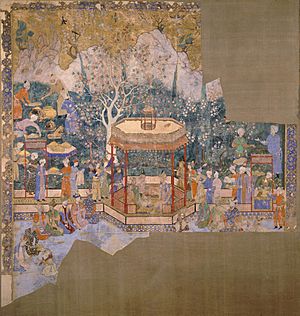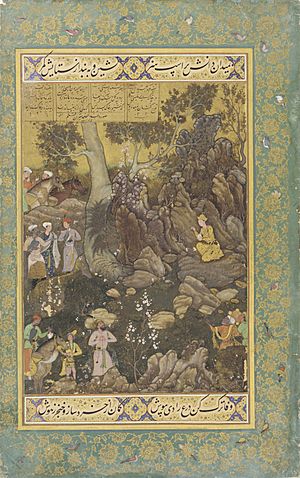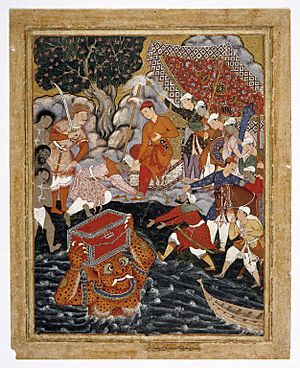Abd al-Samad facts for kids
Quick facts for kids
Abd al-Samad
|
|
|---|---|
| Born |
Khwaja 'Abd-us-Samad
Shiraz, Iran
|
| Nationality | Persian |
|
Notable work
|
Illustration of the Hamzanama; Khamseh of Nizami |
| Awards | Master of the Mint (1576) Dewan of Multan (1584) |
| Patron(s) | Humayun; Akbar |
Abd al-Samad, also known as Khwaja Abdus Samad, was an important painter in the 1500s. He started his career painting Persian miniatures in Iran. Later, he moved to India and helped create the famous Mughal miniature painting style.
Abd al-Samad also held many important jobs in the Mughal Empire. He worked for the Mughal emperors from about 1550 to 1595. Around 1572, he became the head of Emperor Akbar's royal art workshop. Under his leadership, the Mughal painting style became very strong and well-known. Some experts believe that Abd al-Samad might be the same person as another famous Persian artist named Mirza Ali.
Contents
Mirza Ali: A Possible Identity?
Mirza Ali's name first appeared in a famous book of poems called the Khamsa of Nizami, finished in 1543. Records say he was the son of a leading artist, Sultan Muhammed. This means he grew up surrounded by art at the royal workshop. He was known as a very skilled painter.
Some art experts, like Barbara Brend, think Mirza Ali and Abd al-Samad are the same person. They point out that Mirza Ali's known career seems to end when Abd al-Samad starts working for the Mughals. They also see similar styles in their paintings. For example, both artists liked to show detailed courtyards and used colors in similar ways. They also enjoyed painting intricate screens and treated figures in their art in a similar fashion. It's possible the artist changed his name when he moved to a new country.
Abd al-Samad's Career in India
Abd al-Samad was a master painter in the court of Shah Tahmasp I of Persia. He was also a skilled calligrapher, which means he was good at beautiful handwriting.
He first met the Mughal emperor Humayun in 1544. Humayun was living in exile at the time. In 1549, Abd al-Samad and another Persian artist, Mir Sayyid Ali, joined Humayun in Kabul. There, Abd al-Samad was hired to teach Humayun's son, Akbar, how to draw. He might have even taught the emperor himself!
Abd al-Samad, Mir Sayyid Ali, and another artist named Dust Muhammad brought a full Persian painting style to the Mughal workshops. Before this, the Mughal art workshops were smaller. They had artists trained in different places.
Abd al-Samad likely worked on a very large painting called Princes of the House of Timur (around 1550–55). This painting was ordered by Emperor Humayun. Abd al-Samad probably painted the detailed landscape in the background.
In 1552, some of his paintings were part of a special gift. This gift was sent to the ruler of Kashgar. This shows how Humayun was trying to get support to win back his throne. Some of Abd al-Samad's works from this time are in an album in the Golestan Palace in Tehran. These paintings still show a strong Safavid (Persian) style. One painting shows Akbar giving a miniature painting to his father, Humayun. This painting includes Abd al-Samad's name. The figure next to it is probably a self-portrait of the artist.
Abd al-Samad and Mir Sayyid Ali followed Emperor Humayun back to India. This was just seven months before Humayun died in 1556. The young Emperor Akbar, who was only fourteen, kept them in his service. Within a few years, Akbar greatly expanded his royal art workshop.
Abd al-Samad and Mir Sayyid Ali likely worked on the Tutinama. This was the first big art project completed during Akbar's rule.
Around 1572, Abd al-Samad took over from Mir Sayyid Ali as the head of the imperial workshop. This happened because the work on the huge Hamzanama project was going too slowly. The Hamzanama was a massive project with 1400 large illustrations. It was planned to take fourteen years. When Abd al-Samad took over, only four volumes were done after seven years. Under his leadership, the remaining ten volumes were finished in another seven years.
It's not certain if Abd al-Samad painted many of these himself. However, he guided the direction of Mughal painting. He helped create the new style that blended Persian and Indian art. Many artists, mostly Hindu artists like Daswanth and Basavan, were trained by Abd al-Samad. They later became famous Mughal painters.
Abd al-Samad's own paintings were very detailed. He was less interested in the new, dramatic, and realistic style that young Akbar liked. But by the 1590s, his love for detail was popular. After his death, Mughal painting focused more on simpler scenes and human interactions. He wasn't known for realistic portraits, which became a key part of Mughal art. Also, unlike other Mughal artists, he didn't use many ideas from European art.
Later Life and Legacy
In 1576, Akbar put Abd al-Samad in charge of the Fatehpur Sikri mint, where coins were made. In 1582, he became the "overseer of commerce." The next year, he was put in charge of the royal household. In 1584, Akbar made him the dewan (an official in charge of finances) of Multan. He was given a high rank and the special title Shirin Qalam, which means "sweet pen."
These moves might show that he was very good at administration. Some think Akbar preferred a different painting style. But Abd al-Samad kept painting. His last known work is a miniature of Khusraw hunting. This was part of a 1595 manuscript of the Khamsa of Nizami. Other works with his name include a drawing of Akbar with a Dervish (around 1586–87). He likely died in the late 1500s.
Abd al-Samad had two sons who were also painters: Muhammad Sharif and Bizhad. Muhammad Sharif was a friend of the next emperor, Jahangir. Like his father, he was given important administrative jobs. This was very unusual for a family of painters in the Mughal Empire.
See also
 In Spanish: Abd al-Samad para niños
In Spanish: Abd al-Samad para niños





